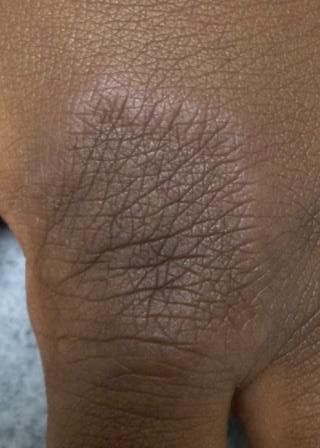Granuloma Annulare
This relatively uncommon inflammatory dermal process has previously been associated with diabetes mellitus and more recently with hyperlipidemia.
Click to enlarge.

[[{"type":"media","view_mode":"media_crop","fid":"28681","attributes":{"alt":"Granuloma annulare","class":"media-image","height":"314","id":"media_crop_7008280069394","media_crop_h":"0","media_crop_image_style":"-1","media_crop_instance":"2928","media_crop_rotate":"0","media_crop_scale_h":"0","media_crop_scale_w":"0","media_crop_w":"0","media_crop_x":"0","media_crop_y":"0","title":" ","typeof":"foaf:Image","width":"419"}}]]
A 5-year-old girl presented with an asymptomatic, slowly enlarging plaque on her dorsal hand for several months, unresponsive to treatment for tinea corporis with topical antifungals.
Key point: The patient presents with an annular violaceous plaque on the dorsal hand with a slightly depressed and hyperpigmented central portion and a rim consisting of distinct papules within the annular border. Notably, the epidermal finding of scaling is absent, which argues against the diagnosis of tinea corporis. As will be discussed, the location and appearance of the lesion along with the patient’s age are highly suggestive of granuloma annulare. Granuloma annulare is a relatively uncommon inflammatory dermal process, named for the palisaded granulomas seen on histopathology and the annular appearance of the lesions clinically. Several forms exist, including localized (more common on the dorsa of the hands and feet), generalized (in a subset of adults), subcutaneous (more common in children on the lower limbs, with some recent literature suggesting a relationship with type I diabetes mellitus), and perforating (referring to the discharge of material from the lesion resulting in crusting).
Interestingly, generalized granuloma annulare has been associated with diabetes mellitus in older, not well-controlled studies, and this finding has come into question more recently in a case-control study that showed no correlation. Meanwhile, current evidence suggests that dyslipidemia is positively associated with granuloma annulare, with reports of resolution of the granuloma annulare lesions after medical treatment of hyperlipidemia.
Treatment: After discussing the diagnosis of localized granuloma annulare and treatment options with the patient’s mother, she elected to monitor the lesion and return for periodic checkups, with the option to apply treatment with a medium-potency topical corticosteroid if the lesion were to continue to expand.
Note: Because granuloma annulare is often self-limited and asymptomatic, observation may be all that is needed. However, topical corticosteroids can be helpful in hastening its resolution, especially in cases in which the lesions are still enlarging. Other localized treatments, such as intralesional corticosteroids, cryotherapy, topical calcineurin inhibitors, and topical imiquimod, have shown efficacy in limited case reports. For generalized granuloma annulare, other interventions, including UV light therapy, doxycycline, systemic corticosteroids, dapsone, hydroxychloroquine, cyclosporine, and TNF-α inhibitors have also been used.